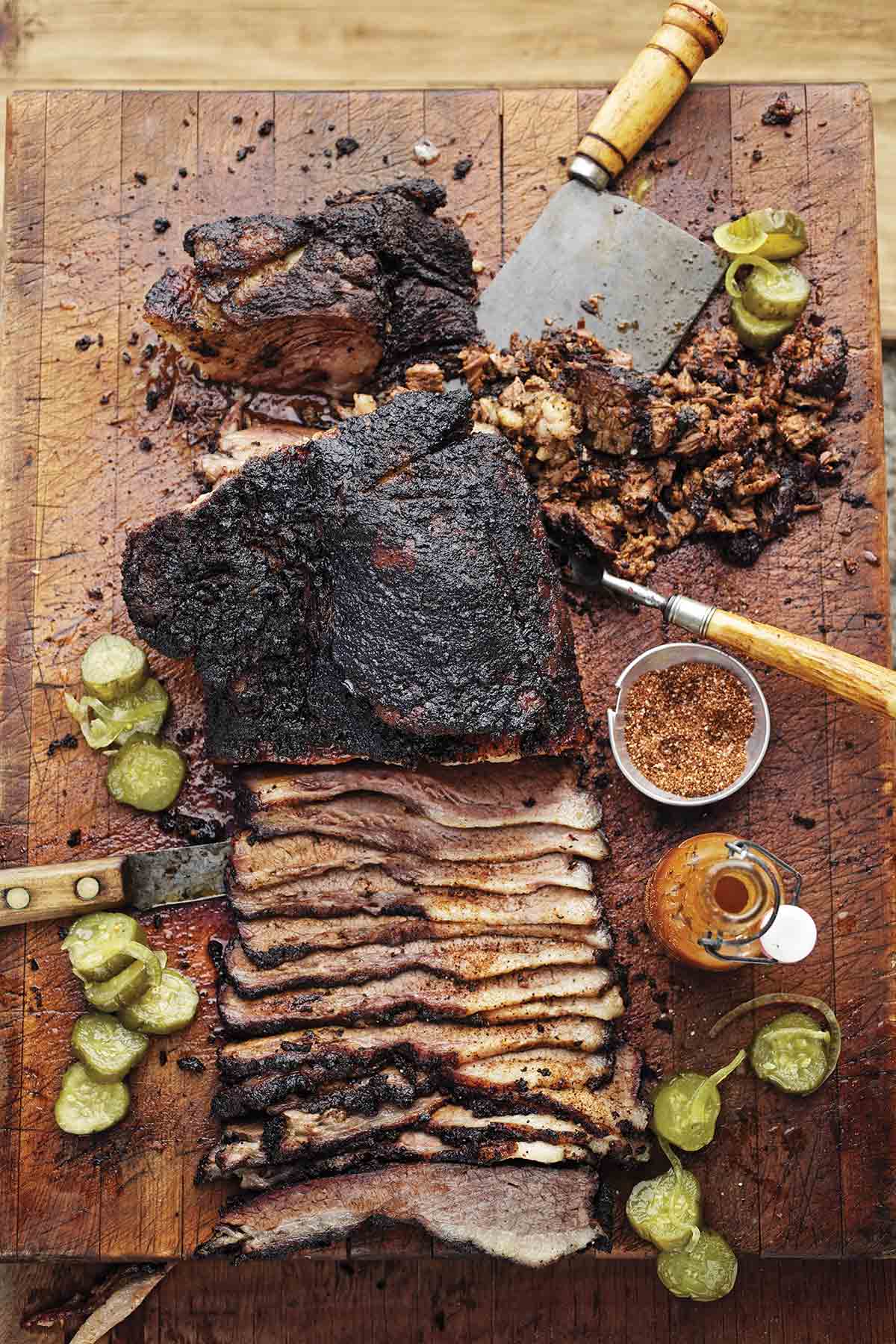
Meat. Fire. Smoke. Behold, the barbecue beef brisket basics. It’s been that way since humans first put meat to heat. And this incarnation, with its just-right spice rub, certainly makes it all seem as God intended.–David Leite
BBQ Beef Brisket FAQs
Coffee makes an incredible rub for beef, especially tough cuts that could use a little bit of extra finesse to make them meltingly tender. Like red wine, coffee is acidic and full of enzymes that work as a meat tenderizer. It also creates a thick, caramelized crust that helps to seal in the moisture to keep brisket juicy
Stick with classic summer side dishes like creamy coleslaw with cilantro, macaroni salad, or easy potato salad.
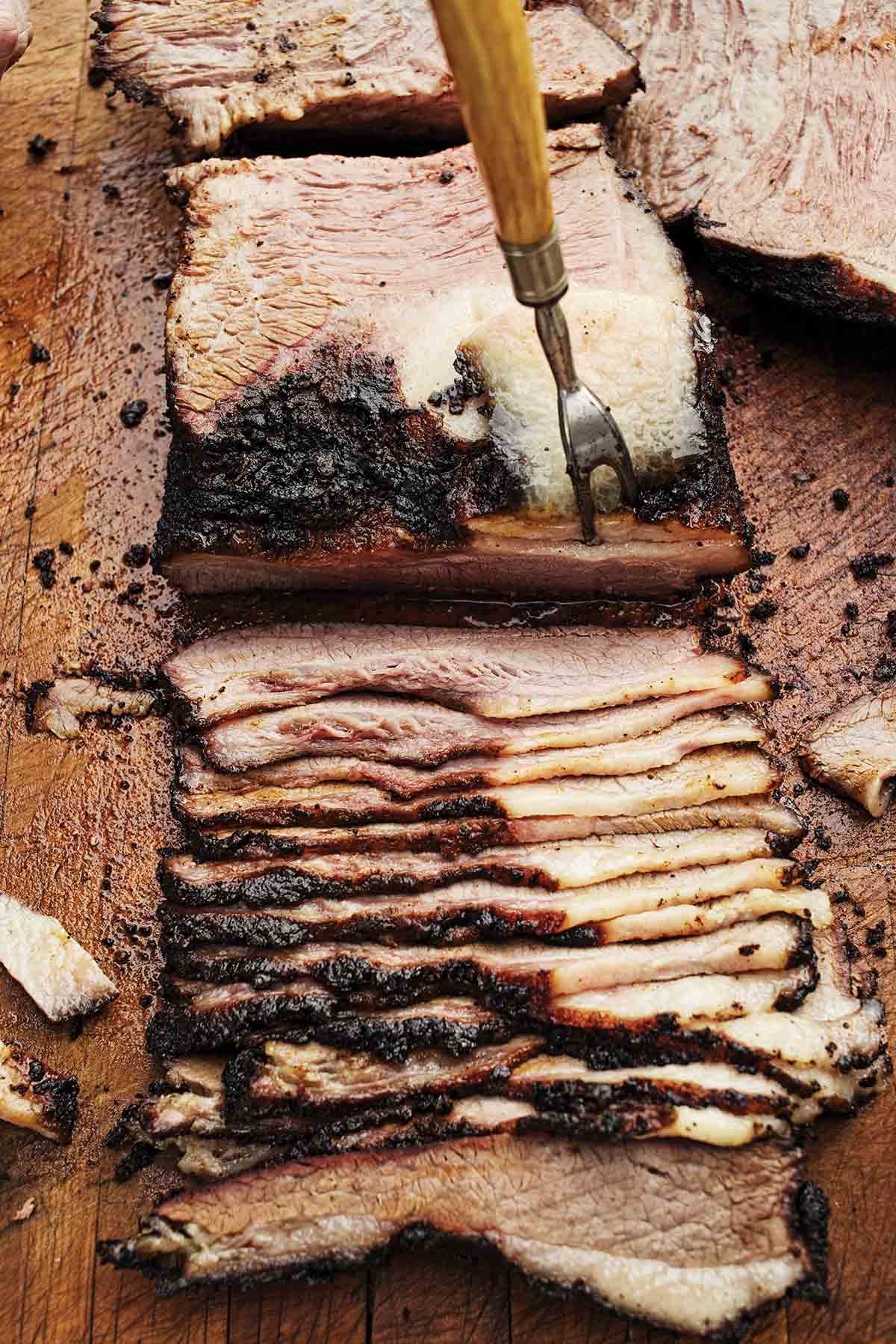
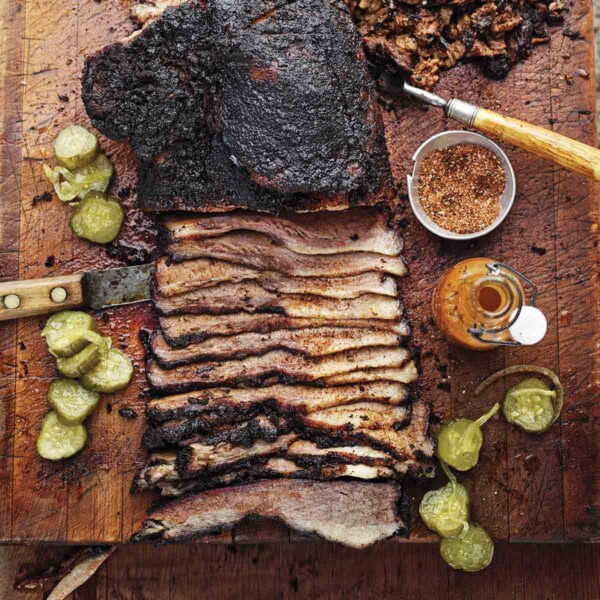
Barbecue Beef Brisket
Equipment
- Smoker
Ingredients
For the coffee rub
- 1/3 cup finely ground dark roast coffee
- 1/3 cup dark chile powder, (meaning ground dark chiles, such as ancho)
- 1/3 cup smoked paprika
- 1/2 cup kosher salt
- 2/3 cup packed dark brown sugar
- 3 tablespoons granulated sugar
- 2 tablespoons granulated garlic
- 1 tablespoon ground cumin
- 1 teaspoon cayenne pepper
For the BBQ beef brisket
- One (12-pound) whole beef brisket
For the barbecue sauce
- 2 cups ketchup
- 2 cups diced tomatoes
- 1 tablespoon store-bought or homemade tomato paste
- 1 1/3 cups distilled white vinegar
- 5 tablespoons Dijon mustard
- 4 teaspoons granulated garlic
- 4 teaspoons kosher salt
- 2 teaspoons black peppercorns, crushed
- 1 cup plus 2 tablespoons packed dark brown or light brown sugar
- 1 1/3 cups cold water
- 2/3 cup molasses
Instructions
Make the coffee rub
- I encourage rolling up your sleeves and using your hands to mix these spices—it helps to capture a feeling of nostalgia for cooking. Mix all the ingredients in a medium bowl, using your hands to break up any clumps. Don't refrigerate. Store in an airtight container in a cool, dry place, such as your cupboard.
Make the BBQ beef brisket
- Pat the brisket dry with a towel to remove any moisture. Generously rub the brisket with 1 cup coffee rub, massaging the spice mixture into the meat. Repeat with 1 more cup rub. The rub will soak up the liquid from the beef and form a crust. Place the meat on a large plate, cover with plastic wrap, and refrigerate for at least 2 hours.
- Prepare a smoker for hot smoking by building a fire and maintaining the coal bed in order for the enclosed cooker to reach a steady temperature for 45 minutes or so, kind of like preheating an oven. Every hour or so of cooking, you need to tend your fire, adding wood and adjusting the coals so it'll smolder and continue to smoke. It’s a good idea to add a drip pan positioned below the meat to prevent flare-ups, as well as a water pan on the grate alongside the meat to ensure the meat doesn’t dry out too much.
- Place the brisket on the center rack of the smoker and smoke for 12 hours. This is slow cooking at its easiest—there’s no need to check the meat at intervals, though you may need to tend the fire. [The standard cooking time for brisket is 1 hour per pound, smoked fat side up, under indirect heat at a steady temperature of 225°F (107°C). The author recommends going for 12 hours, though, no matter the size of the brisket.]
- After 12 hours, use a meat thermometer to check for an internal temperature of 185°F (85°C) in the thickest side of the brisket. Once that temperature is reached, open the door of the smoker and let the meat rest for 30 minutes. This resting period allows the juices to settle. The internal temperature will continue to rise to 190°F (88°C).
Make the barbecue sauce
- While the meat rests, combine the ketchup, tomatoes, tomato paste, vinegar, mustard, granulated garlic, salt, pepper, brown sugar, and water in a large stockpot over medium heat. Simmer for 20 minutes, stirring, until the sauce thickens slightly. Whisk in the molasses last (it will burn if added too early) and blend with an immersion blender until smooth. Season to taste.
- Move the rested BBQ beef brisket to a cutting board, fatty-side up with the wide, taller end to your left. The fully rested meat will have a distinct crust and will be tender and juicy inside. There should be a pink smoke ring beneath the crust. To carve, slice off the top or cap, which is full of most of the fatty, sinuous tissue, and reserve it for chopping. Now that the BBQ beef brisket is an even thickness, remove 2 1/2 inches from the left side, slicing at a 45° angle down and to the left. Next, remove 1 inch from the right side of the brisket in the same way. Reserve these 2 end pieces (often called the “burnt ends”) for chopping if you like. Burnt ends are fully charred and tasty, and many feel this is some of the best meat.
- Slice the remaining center portion of the BBQ beef brisket into 1/4-inch-thick slices. Roughly chop the cap crosswise and lengthwise into 1/4- to 1/2-inch chunks. You can chop the 2 end portions with the cap, if you like.
- Serve the sliced BBQ beef brisket immediately and pass the sauce on the side. If desired, serve the chopped meat immediately as well. [Editor's Note: The author prefers to save the chopped meat for later, when you can season it with some of the leftover coffee rub and a splash of barbecue sauce. We say dig in whenever you wish.]
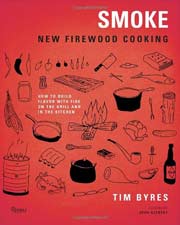
Nutrition
Nutrition information is automatically calculated, so should only be used as an approximation.
Recipe Testers’ Reviews
Coming from Texas and owning a barbecue restaurant, I’m always skeptical of brisket recipes, but this was a great rub and the barbecue beef brisket came out juicy and with just the right smoke ring.
I made the rub with a dark roast coffee that I had ground in my coffee grinder, then I finished the coffee in a blender to grind it even finer. I used a dark chile powder but didn’t have any cayenne so I subbed a teaspoon of ground chipotle pepper for the cayenne. The rub had just the right amount of heat and produced a wonderful taste.
We smoked the brisket for 12 hours using a Traeger smoker and mesquite pellets. After smoking the brisket, I removed the flat portion from the point and chopped the point for chopped barbecue sandwiches, then I sliced the flat portion of the brisket across the grain into 1/4 inch slices. The bark was a little heavy on the bottom, but when added to the chopped meat for sandwiches it was perfect.
I like my sauce to simmer a while so I made the barbecue sauce while the meat was cooking and let it slowly simmer on the stove for about 10 hours. Since it was simmering and never boiled, I added the molasses along with the rest of the ingredients. I liked the sauce for the most part, except it was a little too tomatoey for my liking. I used an immersion blender and the sauce came out thick and smooth.
We happened to be having a cookout with about 40 people the day we tested this and the comments were very favorable. I would make this recipe again, especially the rub. It was excellent.
My husband lived in Texas for nine years and often expresses an interest in doing a Texas BBQ road trip. (We live in an area where there are not many BBQ joints.) After tasting the results of this barbecue beef brisket, I can’t see any reason why we would need to go to Texas.
The coffee cure, or rub, is fabulous, which is good because we have quite a bit leftover. I probably should have cut the recipe in half when I made it, but since it’s so good, I look forward to trying it on other meats. I used ancho chile powder as well as chile de Arbol for the recipe. Since the brisket was going to smoke for hours, I used regular paprika in place of the smoked paprika. The crust on the fat cap made for some of the most delicious fat I have ever eaten, and we really couldn’t resist eating some of it.
The meat is wonderful without the BBQ sauce but is also enjoyable with it. I simmered the sauce for about an hour, just to let the flavors meld. The ingredients work well together and yield a nicely balanced sauce. I particularly like how the sauce works mixed with a lightly dressed, mayo-based classic coleslaw recipe as part of a brisket sandwich. A 6.88-pound brisket smoked for 8 1/4 hours at a temperature of 225°F (107°C) and yielded a generous dinner for 4 as well as lunch the next day for 2 of us and, I’m happy to say, a nice-size piece of leftover brisket that is now in the freezer. I look forward to another delicious dinner on a day when there is no time to devote to making this recipe.
The flavors of this rub and barbecue sauce were so good. The rub came together easily, smelled fantastic right after mixing, and created a great crust on the brisket. The barbecue sauce also came together incredibly easily and tasted great, although you could eat the bbq beef brisket with or without the sauce and still be very happy.
Using temperature rather than time as a gauge, the brisket turned out extremely moist and delicious. I found that the 1 hour per pound wasn’t quite accurate. It actually took quite a bit longer.
There’s a lot about this barbecue beef brisket recipe that I agree with, so let’s start with all the things I think the author got right. I agree that a dry rub is the only way to go for brisket. And I agree with the author’s method of cooking the meat fat side up and leaving it alone during cooking.
I cooked this brisket in my Big Green Egg, which made my job very easy as it can go for many, many hours and hold a constant temperature with no added coals. The Egg was set up for indirect cooking by using an accessory called a “plate setter,” which is a ceramic disc with legs that separates the meat from the coals, and raises the cooking grate higher than its standard position.
I used a combination of guajillo, New Mexican, and cayenne peppers for the “dark chile powder” called for. This part of the recipe is a bit confusing, because “chile powder” might contain spices and salt besides just chiles. I assumed the author really meant just pure ground chiles, so that is what I used and it made for a good rub.
My brisket wasn’t as large as the one called for, so I used the author’s hours-per-pound guideline. My brisket took a bit longer than indicated by the author’s guideline. If you’re going to cook brisket, you really need to use a thermometer to make sure you get the meat to the proper temperature, and not just go by hours. And yes, the meat really does need to end up at 190°F (88°C), as specified in the recipe.
There are several styles of barbecue in Texas. I’ve had it all, but I’m partial to the central Texas-style, which is the “no sauce, no sides, no silverware” variety, where the focus is completely on the meat. This recipe is more of an east Texas-style, with a rich red sauce to go with it. With my central Texas bias, I demand of all barbecue recipes that the meat be tasty without any sauce, and this brisket passed the test. I strongly urge you to serve it without the sauce and let everyone add sauce to taste at the table. That said, the sauce for this recipe is a perfectly good deep red barbecue sauce made in the East Texas-style. If it sounds good to you, make it. But if you want to be more of a purist, the meat is great without the sauce, too.
The author calls for you to remove the fat cap after cooking, but I didn’t do this, and I wouldn’t in the future. First, the fat is softened and rendered enough that it is not unpleasant at all to eat. Second, I’d prefer to give my guests the choice of whether or not to eat the fat.
My one other quibble with this recipe is the inclusion of smoked paprika in the dry rub. This is a trendy ingredient, not traditional in a Texas rub. Also, I am somewhat philosophically opposed to adding smoked ingredients to a rub or a sauce if the meat is being smoked. The smoke flavor in the meat should come from the cooking method. And the rub surrounding the meat will be plenty smoked by the end of cooking. You wouldn’t add liquid smoke to your sauce, would you? (No, you wouldn’t.)
I make rubs all the time, and this is a lovely rub. I expected it to be a bit lacking, as many coffee-based rubs usually have a laundry list of ingredients, but the chipotle and the paprika really sing in this rub. We enjoyed it on a flat-iron steak with stellar results. Directions suggest that it will keep for a month, but I suspect that you will use it time and time again before then.
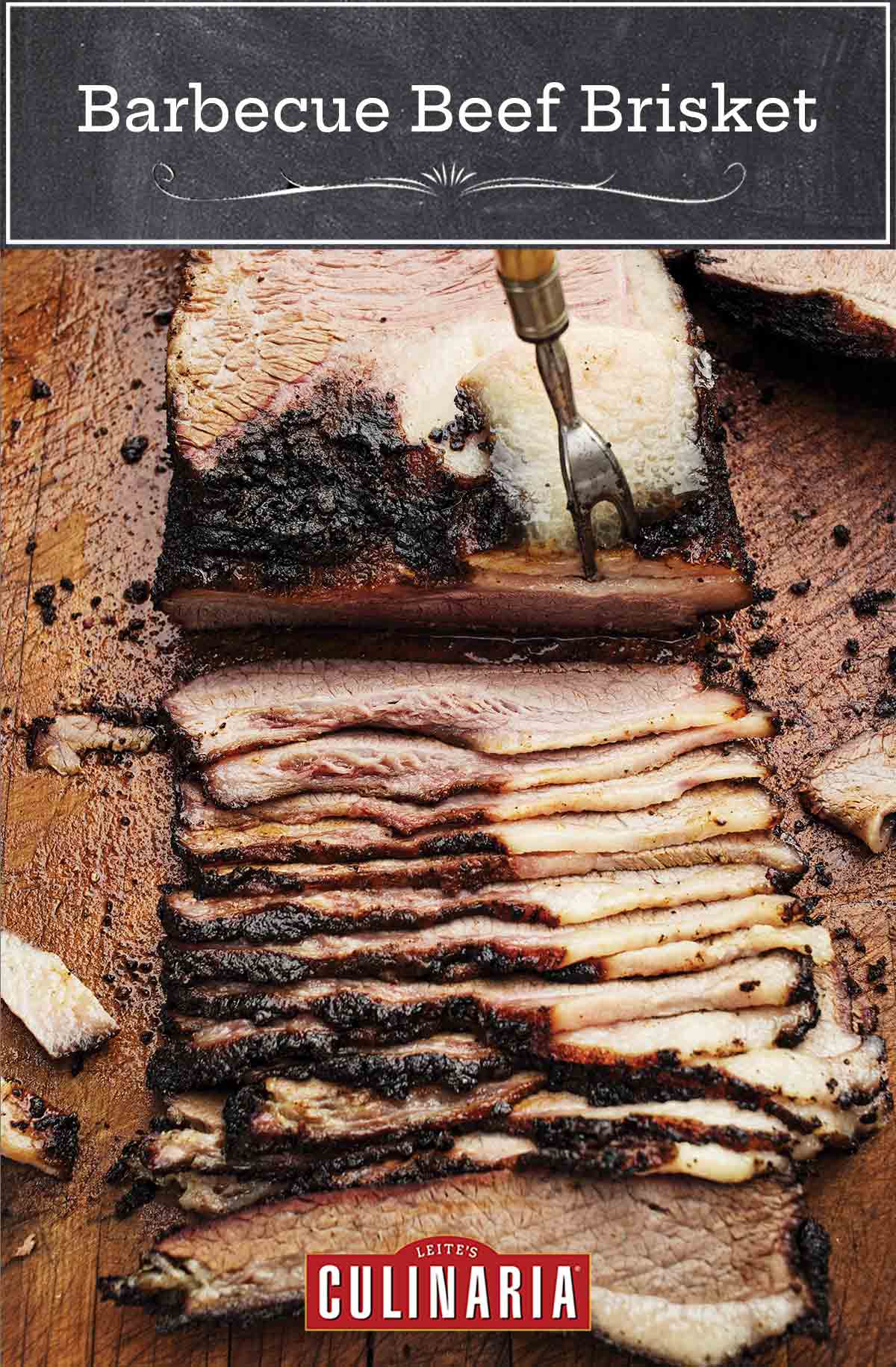













I made this over the weekend for a family gathering and it was great. I have cooked a lot of brisket and have tried different coffee rubs but this was a keeper. I made the sauce as well, but I’m not much of a sauce person. Everyone else liked it though. I had a pretty decent sized brisket so I was able to make burnt ends as well. I will definitely use this rub again.
Magnificent, Cheryl F.! Done to perfection. I’m not a sauce person either and love that you felt this rubbed brisket held its own perfectly fine unadorned.
I tend to agree the photo makes it look dry. The major evidence of this is in the first slice where you can see the ridge marks where the slicer probably had trouble just getting a knife through it. I also can’t detect anything that resembles a smoke ring.
The slicing instructions are also a little too specific. Most briskets as they get larger develop a curved grain. Slicing needs to accommodate that grain. It can’t be assumed a certain angle will do the job.
Minor note on the burnt ends. Traditionally, the burnt end is the side where the point was turned towards the firebox. On the flat usually it is furthest from the fire and doesn’t get that level of char. Nowadays most people separate the point and flat and only use the point for burnt ends and cook that while the flat rests.
Rub idea looks good in concept. Execution is a bit iffy. Keep in mind roughly 95% of KCBS competition chefs do steam their Briskets in comps. Only the most hardcore enthusiasts don’t steam. (wrap) for someone doing their first to tenth brisket I’d never advise doing anything but wrapping at the stall.
Thanks for the input, culdeus. Always open to learning something! We’ve also learned that there are a lot of ways to cook brisket, and a lot of ways to rub it, and a lot of ways to carve it. Appreciate the insights, may it help folks form their own opinions as they go about the learning curve of proper brisket-making.
Not to be a killjoy, but the brisket in the photo looks pretty awful. That’s one dry looking hunk of meat. Just sayin’.
By its nature, smoked brisket is going to be relatively drier than, say, braised brisket. What can we say? We saw this recipe, liked the photo, became intrigued by the ingredients and technique, and loooooved the outcome, as evidenced by all those comments you’ll find beneath the recipe from our dedicated and trustworthy testers. So sorry you don’t care for the photo, but hope you try the recipe.
Funny because I thought the exact opposite than bkhuna. I think it looks rather deliciously moist. There are a lot of juices on the board and there is also all of that luscious fat…mmmm! Anyway, my experience with Leite’s Culinaria is they get it right about 95% of the time, so I would definitely try this.
Mwuah! (That’s us sending you smooches as a thank you, Rhonda35.) That’s what we thought, too. Appreciate your vote of confidence. We’re gunning for 100% of the time, though, so kindly let us know if we don’t get something right.